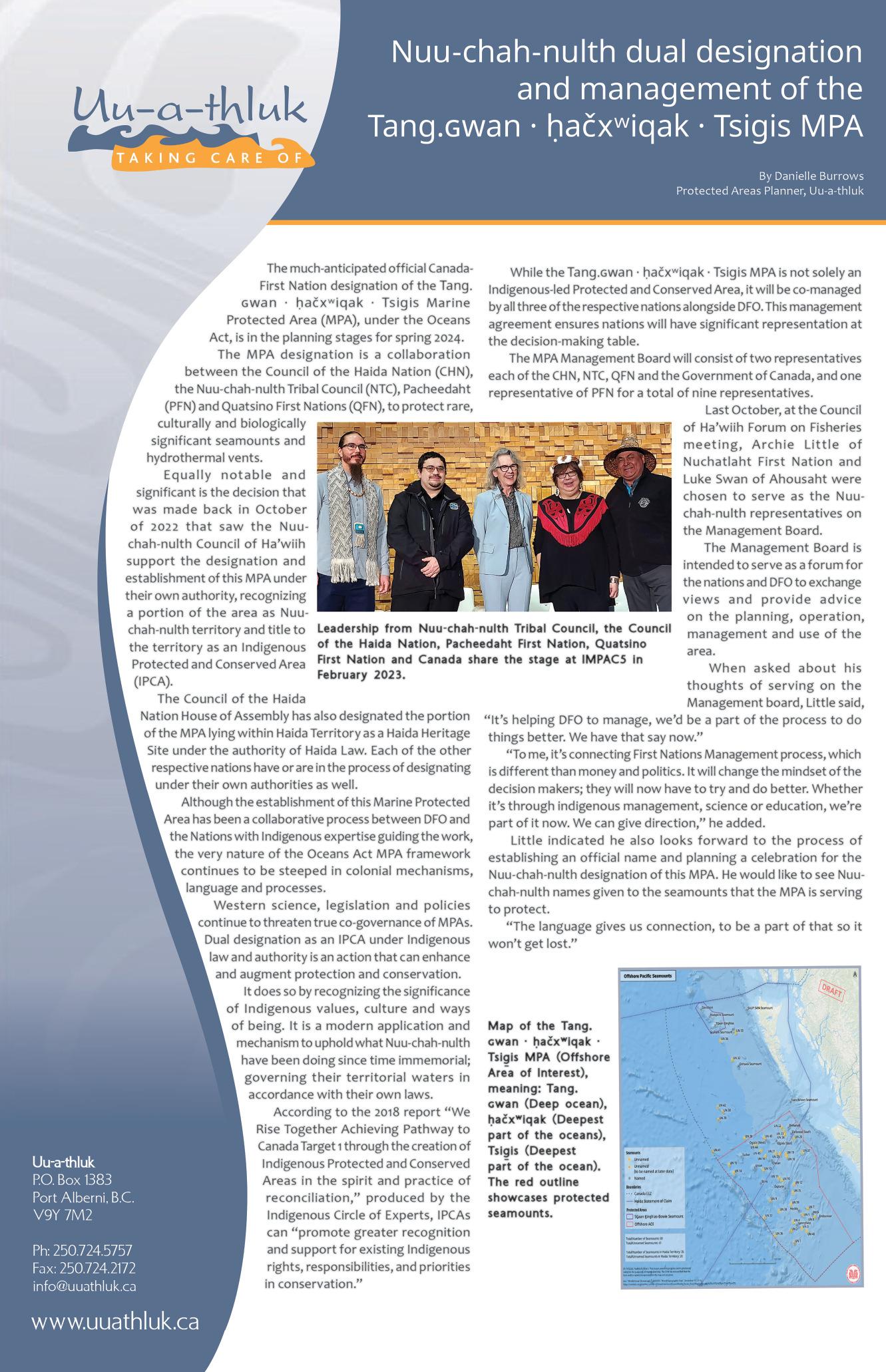






Prince Rupert, BC - The Hesquiaht Descendants ladies team made history at the 64th annualAll Native Basketball Tournament in Prince Rupert, B.C. on Feb. 11 to Feb. 18.
Captained by Mariah Charleson, the squad of nine players battled their way to the final game of the tournament, becoming the first-ever Hesquiaht team to make the top two.
Charleson professed a deep “Klecko Klecko” to all the supporters who sent messages and cheered them on throughout the weeklong event.
“What we represented is the style of basketball that we played in Nuu-chahnulth territory,” Charleson said. “It’s hard, it’s gritty, it’s tough. We battle. We don’t have the height that some of these teams have, but we’ve managed to shut down teams far bigger than us just with outright hustle, grit and by never, ever giving up. That fight we have within ourselves; that’s Hesquiaht basketball. That’s Nuu-chah-nulth basketball.”
Hesquiaht beat NewAiyansh 70-47 in their first game, they took down Kitamaat 55-46 in game two, Vancouver fell
55-50 in game three, and game four was a heartbreaking 59-52 loss to Similkameen, which sent them to the losers bracket and semi-final against Greenville. Hesquiaht rallied to secure a 74-51 win against Greenville and a re-match against Similkameen.
Charleson said they had them in the first half, but “came out flat” in the second half. Similkameen would take the tournament win 50-29 from the Descendants.
“We played extremely talented teams the whole way through; not a single easy match-up the entire week. The only team we couldn’t get past was Similkameen,” said Charleson, who was named an All-Star for the entire tournament of 17 teams.
Teammate Skylene Patrick, 33, also picked up major hardware, earning TournamentAll-Star and Best Defensive Player.
“Growing up with my dad Tyson Touchie, he just always emphasized the importance of defense. It was really my goal to be a strong help side for my teammates and to hustle for the ball as much as possible. I got tied up in a lot of jump balls all weekend; just little tips and steals and being smart with my fouls,” said Patrick, a mother of three.
Patrick was joined on the Hesquiaht bench with her momAnita CharlesonTouchie and sister Jada Touchie.
“It was super meaningful to play with my mom and Jada,” she said. “We have a lot of feisty, aggressive Hesquiaht women. Everybody had bumps and bruises. Everybody had band aids. Everybody was willing to work really hard.”
Jada Touchie, 20, was named Most Outstanding Player of the tournament.
“Making it to the final is a really big push for me to want to develop as a basketball player and train harder. We were so close,” said Touchie. “I am so thankful to be part of this team. There is a big history of basketball in our family. I grew up watching my older siblings play, my parents, and even my grandparents. I felt really proud to represent my late grandfather Con Charleson.”
To prepare for each game, the Descendants sang Hesquiaht songs in the changing room and gave thanks to their Ancestors and to the Creator every morning. Team rookie Brandis Lucas, 18, says it might have been that team spirit that gave them the edge.
“We have a group chat and someone would send a video of an eagle sitting outside their door or whatever. We took
everything as a sign. Being that cultural and connected to the land, I want to say it definitely helped us make it that far,” said Lucas.
Touchie agreed.
“Alot of us are going through hard times and grieving, so we felt it was really important to ground each other and be connected culturally. We went to the water together and had dinner and had our smoked fish together. That was so comforting to feel that connection while we are so far from home. We did a really good job uplifting each other,” said Touchie.
While some of the players flew in and out of Terrace, most of the team drove to Port Hardy and took the 21-hour ferry ride to Prince Rupert for the event. Entry to theAll Native Basketball Tournament is $1,000 per team and each player receives a per diem of $20 per day they stay in the competition.
“We have mothers away from their children, we’re taking time away from our jobs, so we’re not getting paid, so (the per diem) is a big help.And it’s a big, massive commitment just to have our nine players present the whole week,” said Charleson, adding that they will be back next year — even stronger.
Vancouver, BC- For over three decades, Valentine’s Day in the Downtown Eastside (DTES) marks the commemoration of Indigenous women and girls who are missing and murdered. But women and girls have continued to go missing and be murdered, leading family members and advocates say not enough is being done to protect Indigenous people.
Sheridan Martin of Gitxsan Nation attended this year’s memorial march with her mother, daughter and granddaughter to honor her sister, Cindy Martin, who went missing in 2018. For five years no one knew what happened to Cindy, but onAug. 9 of 2023 Cindy’s remains were discovered.
“If you rewind it 20 years ago, Cindy was the one that brought us here,” said Sheridan of the DTES Memorial March, adding that Cindy was involved in advocating for missing and murdered women and girls.
Cindy had lived in Vancouver working as an Indigenous advocate for the school board and teaching Indigenous women and girls from the Downtown Eastside how to drum and sing. But at the time of her murder, she was in her hometown in northern B.C.
“This is important for me, because the murdered and missing Indigenous women started going missing in, probably, 1970,” said Sheridan. “Fast forward to 2024, and it hasn’t slowed down.”
According to statistics Canada, 490 Indigenous women and girls were murdered between 2009 and 2021, translating to a
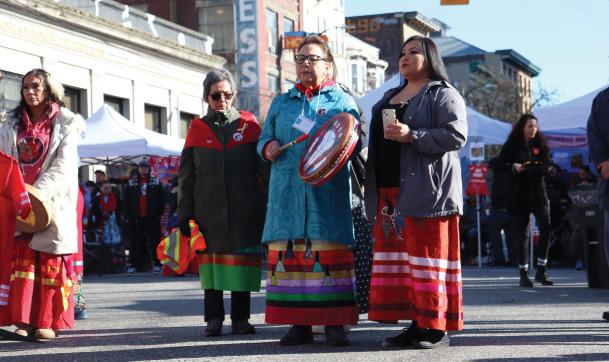
On Feb. 14 the streets of the Downtown Eastside were filled for an annual walk.
rate that is six times higher than nonIndigenous women.
Indigenous women and girls are overrepresented as victims of homicide. During this time period they made up almost three per cent of Canada’s population, Statistics Canada reads, while accounting for between five and seven per cent of victims.
“[I’m] highly aware that my granddaughter can go missing because she’s Indigenous,” said Sheradan. “It’s about my daughter going missing because she’s Indigenous, because she’s a woman, because she’s a female.”
Karen Williams of Gitxsan was at the march in memory of her sister,Alberta Williams, who went missing in 1989.
“It’s very uplifting, very uplifting and positive,” said Williams of the Memorial March. “To come and support one another.”
“Indigenous women are not valued as women in a place where it’s our land,” said Williams. “We should be standing together to stop that.”
Carol Martin has worked in the DTES women’s centre and been involved in the Memorial March since it began.
“Women still to this day continue to go missing, nothing has really changed,” said Martin.
“This whole platform is to bring awareness that things haven’t changed for us Indigenous women, our sacred givers of life,” said Martin. “They’re to be honored, they’re to be respected.”
But Martin shared that Canada needs to shift the way Indigenous women are thought of.
“When the media starts talking about these things, the first thing they say is she was a working girl, or she lived a highrisk lifestyle,” said Martin.
“I think at birth, we’re at a high-risk,” Martin added, “lifestyle as Indigenous women.”
The Final Report of the National Inquiry into Missing and Murdered Indigenous Women and Girls was published in 2019. Since then, Martin said that there has been very slow progress.
“Where’s the response from the government?” she said. “The work is not being put into place to make those changes, and it needs to happen soon.”
For Sheridan Martin, layers of oppression, poverty and systemic racism need to be addressed to stop Indigenous women and girls from going missing.
“How do we start peeling those layers back and really taking a look at how humanity has treated our Indigenous women and girls,” said Sheridan.
“We have to stop them from going missing,” added Sheradin. “How do we put the face of humanity on each Indigenous woman and girl so they’re not looked at as something to be killed and discarded?”
“If we stand in solidarity, we become a louder voice,” she continued. “It’s not just one voice or thousands of voice[s]; this [march] is sending out a message across Canada.”
Sheridan hopes that in her granddaughter’s life she sees changes and that there no longer Indigenous people going missing and being murdered.
“I see that hope is still surviving, and hoping to find justice for what happened to the women - especially at the Pickton farm,” said Carol, as she explained the yellow roses used in the march represent hope.

Ahousaht, BC –Ahousaht leadership issued a joint statement on Feb. 6 that the nation is not prepared to host Canoe Journeys in 2024. The statement was made on behalf ofAhousaht Hawiih (hereditary chiefs) and the elected chief and council.
InAugust 2023 a video made at Ahousaht’s Thunderbird Hall showed a group of about 30 members inviting people to the Flores Island community for a potlatch on July 29, 2024. With the hashtag ‘RESPECT – Gathering of families’, people were invited to land inAhousaht, presumably by canoe, on July 28. The potlatch was scheduled to continue untilAugust 2, 2024.
The news was met with excitement and anticipation up and down coastal British Columbia and Washington State. Word spread quickly through social media.
ButAhousaht Ha’wiih and elected leadership say they were not consulted when the invitation was made and could not ensure the safety and comfort of such a large volume of people coming to their remote, island home.
TysonAtleo, ʔeʔqatiʔis, is next in line for his father’s Ha’wilth seat and is a board member of the Maaqutusiis Hahoulthee Stewardship Society. Speaking on behalf ofAhousaht leadership, Atleo told Ha-Shilth-Sa that the chiefs and council were not adequately consulted about the extended potlatch and the nation is not prepared to take on an event of this magnitude on relatively short notice.
When asked why it took six months for leadership to make their announcement, Atleo said they want to respect the intent and desire to host, “but we want to make sure everyone is supported and can coordinate an incredible and safe experience.”
“Leadership wanted to ensure that they are a united voice in either trying to support or not move forward with this opportunity,”Atleo continued.
In the end, they determined that there’s no safe way to effectively host this year.
Ahousaht hosted an event called Journey Home toAhousaht – Canoe Quest 1999. InAugust of that year Ha-Shilth-Sa reported that planning and fundraising for the event began two years earlier.
Thousands of people arrived inAhousaht for the event, with “more than 45 canoes” lining the beach.
“1999 was a different era of canoe journeys,” saidAtleo.
Much has changed since then, including the greater number of canoe families.
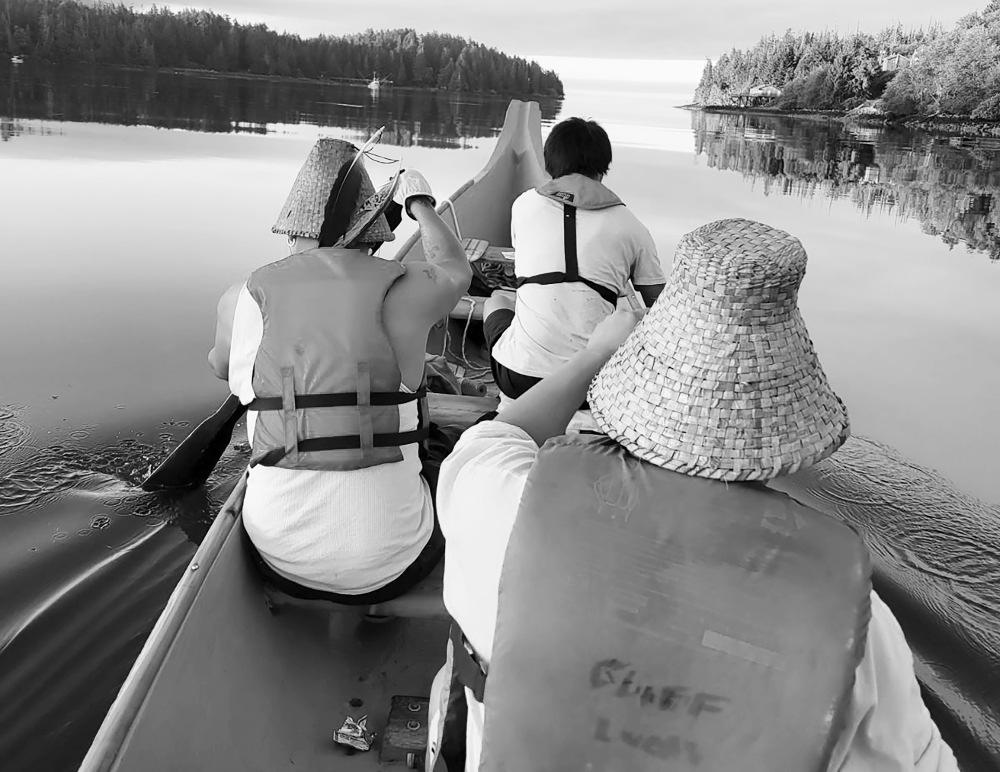
Groups from across the West Coast have been preparing for a paddle toAhousaht this year, but the First Nation’s hereditary and elected leaders have cancelled the event, citing a lack of adequate resources in place and a lack of approval from Ahousaht Ha’wiih.
Last summer the Paddle to Muckleshoot brought over 90 canoes to the destination inAuburn, Washington. Several Nuu-chah-nulth groups paddled down the coast for several days to the Muckleshoot Indian Tribe’s land, where a week of festivities ended onAug. 6, 2023. Over this journey the canoe families stopped at First Nation communities along the West Coast.
“It’s much bigger, more commercial and the expectation of the host community is to be able to provide things like medical services, parking, washroom and cleaning facilities. It takes a lot of resources and financial capital, on a commercial scale,” Atleo told Ha-Shilth-Sa.
On Feb. 6,Ahousaht leadership delivered a statement that read, “On behalf of theAhousaht Ha’wiih (Hereditary Chiefs) andAhousaht Chief and Council (collectively ‘Ahousaht Leadership’) we issue this statement regarding the announcement forAhousaht to host the 2024 Canoe Journeys. Hawiih ƛakišwaya (John


Keitlah) will not be openingAhousaht beaches for the 2024 Canoe Journeys. Ahousaht Leadership will not be hosting the 2024 Canoe Journeys and we expect all organizing committees to respect this decision.”
They went on to state that while they recognize and appreciate the healing value of Canoe Journeys, the announcement was made without consultingAhousaht Leadership.
“This was a violation of our traditional protocol,” they wrote.
“Further,Ahousaht and the surrounding region, including the District of Tofino, are not prepared to host the 2024 Canoe Journeys.Ahousaht and Tofino currently lack the necessary infrastructure (ex. parking, accommodations, food services, washroom facilities, medical and security services, etc.) to effectively and safely host the volume of canoe families that participate in Canoe Journeys,” reads the statement fromAhousaht leadership.
With that being said,Ahousaht leadership say they are working on developing infrastructure that could allow them to host events on the scale of Canoe
Journeys in the future.According to the leadership statement,Ahousaht is in the development stages of several key infrastructure projects that are due to be completed in the coming years.
“With an adequate and inclusive planning processAhousaht Leadership will work with the organizing committee to consider hosting the Canoe Journeys in approximately five years. We apologize for any inconvenience and appreciate your respect for our declaration,” reads theAhousaht leadership statement.
“Leadership wants to respect the wishes of muschim and know thatAhousaht is recognized as a culturally strong community,” saidAtleo. “Many of our members travel to journeys and we want to ensure that we are prepared to offer that same level of comfort and care for people that visit us.”
He believes it will take a minimum of five years planning for such a large event given the remote location ofAhousaht.
“We respect Canoe Journey and value what they provide. We want to uphold canoe journeys and make sure it’s done properly,” saidAtleo.

Ha-Shilth-Sa newspaper is published by the Nuu-chah-nulth Tribal Council for distribution to the members of the NTC-member First Nations, as well as other interested groups and individuals.
Information and original work contained in this newspaper is protected by copyright and may not be reproduced without written permission from:
Nuu-chah-nulth Tribal Council P.O. Box 1383, PortAlberni, B.C. V9Y 7M2.
Telephone: (250) 724-5757
Fax: (250) 723-0463
Web page: www.hashilthsa.com
facebook: Hashilthsa Ntc
2024 Subscription rates:
$40 per year in Canada and $45 per year in the U.S.A. and $50 per year in foreign countries. Payable to the Nuu-chah-nulth Tribal Council.
Manager/Editor/Reporter
Eric Plummer (Ext. 243)
(250) 724-5757 Fax: (250) 723-0463 eric.plummer@nuuchahnulth.org
Reporter Denise Titian (Ext. 240) (250) 724-5757 Fax: (250) 723-0463 denise.titian@nuuchahnulth.org
Reporter
Alexandra Mehl (Ext. 286) (250) 724-5757 Fax: (250) 723-0463 alexandra.mehl@nuuchahnulth.org
Audio / Video Technician
Mike Watts (Ext. 238) (250) 724-5757 Fax: (250) 723-0463 mike.watts@nuuchahnulth.org
EditorialAssistant
Holly Stocking (Ext. 302)
(250) 724-5757 Fax: (250) 723-0463 holly.stocking@nuuchahnulth.org
Please note that the deadline for submissions for our next issue is
March 1, 2024
After that date, material submitted and judged appropriate cannot be guaranteed placement but, if material is still relevant, will be included in the following issue.
In an ideal world, submissions would be typed rather than hand-written.
Articles can be sent by e-mail to holly.stocking@nuuchahnulth.org (Windows PC).
Submitted pictures must include a brief description of subject(s) and a return address.
Pictures with no return address will remain on file.Allow two - four weeks for return.
Photocopied or faxed photographs cannot be accepted.
Although we would like to be able to cover all stories and events, we will only do so subject to:
- Sufficient advance notice addressed specifically to Ha-Shilth-Sa.
- Reporter availability at the time of the event.
- Editorial space available in the paper.
- Editorial deadlines being adhered to by contributors.
Ha-Shilth-Sa will include letters received from its readers. Letters MUST be signed by the writer and have the writer’s full name, address and phone number on them. Names can be withheld by request.Anonymous submissions will not be accepted. We reserve the right to edit submitted material for clarity, brevity, grammar and good taste. We will definitely not publish letters dealing with tribal or personal disputes or issues that are critical of Nuu-chah-nulth individuals or groups.
All opinions expressed in letters to the editor are purely those of the writer and will not necessarily coincide with the views or policies of the Nuu-chah-nulth Tribal Council or its member First Nations. Ha-Shilth-Sa includes paid advertising, but this does not imply Ha-Shilth-Sa or Nuu-chah-nulth Tribal Council recommends or endorses the content of the ads.
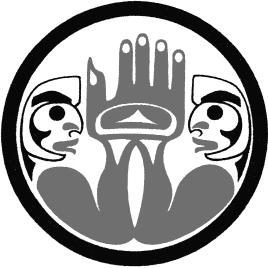
In the wake of the nine-to-five hustle, juggling the demands of work, school, and family, oftentimes takeout caffeinated drinks save the day. But health professionals share that many pre-sweetened caffeinated drinks have a higher sugar, fat and calorie content than people are aware of.
“Alot of people don’t know necessarily how many calories and how much sugar is in a lot of the drinks that they consume,” said Jen Cody, a dietician with the Nuu-chah-nulth Tribal Council. “Most of the drinks that are available through [Tim Hortons] or Starbucks…have a surprising amount of fat and sugar in them.”
At Tim Hortons a medium double double contains 200 calories with 13g of fat and 21g of sugar (five teaspoons), at Starbucks a grande caramel macchiato contains 250 calories with 7g of fat, and 33g of sugar (8 teaspoons), and at McDonald’s, a French vanilla cappuccino contains 260 calories, 6g of fat, and 34 g of sugar (8 teaspoons). To compare, a can of Coke contains 39g of sugar (9 teaspoons).
Canada’s Heart and Stroke Foundation recommends “no more than” 48 grams (11 teaspoons) of added sugars in a day. But for a healthy diet, less than half of that is recommended for the average 2,000 calories a day.
According to Diabetes Canada, Canadians eat an estimate of 110g (26 teaspoons) of sugar each day for a 2,000 calorie-a-day diet, which includes sugars added to food and drinks, as well as naturally occurring sugar in milk products, vegetables, and fruit. Based on a 2004 study, 35 per cent of an adult’s daily sugar consumption was attributed to beverages.
“We are a culture that is really focused on sugar in our diet, and the more sugar that we have, the more that we want,” said Cody.
“Everybody’s on this colonial diet now,” said MatildaAtleo, an Indigenous educator in diabetes at the First Nation Health Authority (FNHA).
Cody explains that in one year, if a person consumes 100 extra calories per day, they will gain roughly 10 pounds.
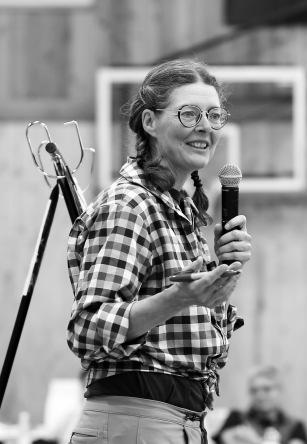
“Ten pounds has an effect on your heart and on your blood, and on all different aspects of your health,” said Cody.
According to Canada’s Heart and Stroke Foundation, overconsumption of sugar can lead to heart disease, stroke, obesity, diabetes, high blood cholesterol, cancer, and cavities.
“I think it’s just really important to bring out that awareness of the sugar content and what happens when you consume so much sugar,” saidAtleo.
High consumption of sugar in one’s diet in combination with no physical activity will cause weight gain and those factors alone are connected pre-diabetes, said Alteo.
Cody adds that some caffeine drinks can take up a significant portion of the recommended daily calorie intake, especially in the larger sizes. One drink could lead to an extra 200 to 500 calories a day, she continued.
Starbucks’Grande Caramel Ribbon Crunch Frappuccino contains 470 calories, 22g of fat, and 60g of sugar (14 teaspoons), while at McDonald’s their medium Mocha Frappe contains 490 calories, 20g of fat, and 60g of sugar (14 teaspoons). Tim Hortons medium Mocha Iced Capp contains 530 calories, 24g of fat and 72g of sugar (17 teaspoons).
“It’s really easy to drink a lot of calories very quickly and not register that you’ve had that [many] calories in a short

Ha-Shilth-Sa belongs to every Nuu-chah-nulth person including those who have passed on, and those who are not yet born.Acommunity newspaper cannot exist without community involvement. If you have any great pictures you’ve taken, stories or poems you’ve written, or artwork you have done, please let us know so we can include it in your newspaper. E-mail holly.stocking@nuuchahnulth.org. This year is Ha-Shilth-Sa’s 50th year of serving the Nuu-chah-nulth First Nations. We look forward to your continued input and support. Kleco! Kleco!
period of time,” said Cody. “Your body doesn’t really have the time to respond… and then adjust to what that means in the calories that you have later on in the day.”
“I think that having those treats occasionally is great, and if they want to have it as sweet as they like it, then that’s okay,” said Cody. “It’s when you’re having that treat every day or having it more than once a day.”
For those who are having high sugar treats every day or twice a day, she suggests asking yourself why it’s fulfilling and how it could affect your health overall. Cody recommends being more aware of how you feel 45-minutes to two hours after consuming a sugary drink, ordering the smaller size, or half sweet.
But she also suggests choosing a different drink entirely that has lower fat and sugar contents.
“When it comes to coffee, I think, keep it simple, don’t add sugar,” saidAtleo. “People in Italy, they have espressos, little cups of strong coffee, [with] nothing added.”
“They enjoy the taste of coffee, they don’t add all the stuff to it,” saidAtleo.
Cody suggests drip coffee or anAmericano, and adding a small portion of cream and sugar to taste rather than ordering a pre-sweetened drink.
Flavoring water with fruits, berries, and herbs is another suggestion Cody made to help stay hydrated and connect people to traditional food and medicines.
“I’ve talked to so many people who have decided, with this new year, that they [want to] cut sugar out of their diet, and they have stepped away from a lot of the drinks that they have been having that have a lot of sugar,” said Cody. “That evened out their energy for the whole day, and they feel a lot better.”
Cody recommends having a good breakfast, lunch and dinner to maintain energy throughout the day.
“You’re eating regularly during your day, and having foods that are low in sugar will really help,” said Cody.
“I think it’s always been a concern and I think we need to take it more seriously,” saidAtleo. “[People] really have to be conscious of the amount of sugar and try to cut back and just have plain coffee.”
The advertiser agrees that the publisher shall not be liable for damages arising out of errors in advertisements beyond the amount paid for space actually occupied by the portion of the advertisement in which the error is due to the negligence of the servants or otherwise, and there shall be no liability for non-insertion of any advertisement beyond the amount paid for such advertisements
PortAlberni, BC – “Why pay for something when you have the right to get it free?” askedAlberni Pharmacy pharmacist and owner, Farah Kassam.
Having worked in pharmacies in Vancouver and Nanaimo, Kassam landed in PortAlberni and opened her own business in December 2022. She noticed that many First Nations customers come in to buy things they can get for free with their Indian Status cards. It is not unusual for her to ask new customers if they have status – and for First Nations people, they know immediately what Kassam means.
“Not many people know about Plan W,” said Kassam, adding she thinks only two out of every 10 people are aware of it.
Bijan Mahmoudi, a pharmacist and owner of Shopper’s Drug Mart in Port Alberni, agrees that it’s important for First Nations people to get familiar with the Plan W OTC list, and should even have it printed. But, he says it’s just as important to talk to a pharmacist about your symptoms and needs.
“Allergies, for example, some think they have an eye allergy but it could be something else,” said Mahmoudi. “To get the best care you have to come in and talk to the pharmacist.”
The First Nations HealthAuthority (FNHA) provides pharmacy benefits for Indigenous people in the province through a partnership with BC PharmaCare and Pacific Blue Cross. PharmaCare Plan Wellness (Plan W) is the drug benefit plan for FNHAclients.
Plan W covers 100 per cent of eligible prescription costs for status First Nations people and also covers certain over the counter (OTC) medication and supplies.
The Plan W over the counter list is updated quarterly. Kassam says items on the list have changed over time, and so have rules about access to the medications.
She says the Plan W OTC list is developed by people with an awareness of the health needs of First Nations people. For example, she noted that residential school

survivors were often given watery powdered milk at the institutions.As a result, many have developed lactose intolerance. For that reason, the OTC medication, Lactaid, can be obtained for free by status First Nations people.
Prior to the COVID-19 pandemic, First Nations people had to visit their doctor to get a prescription or a note for Plan W OTC items. But with the strain on the healthcare system in recent years, rules were relaxed. Today, status First Nations people can go straight to the pharmacy to get things likeAspirin, antihistamines, vitamins, bandages, medicated creams and ointments, laxatives, antacids and so much more for free, provided it is on the

service.
Kassam says this process has helped her catch things that could have caused serious problems. One man, for example, had no family doctor and was prescribed a heart medication in the hospital.After finishing his supply of medication, the man came to the pharmacy thinking he neededAspirin.
Aware that it is unsafe to abruptly stop the medication the man was on, Kassam arranged an online appointment with FNHA’s Doctor of the Day. This is a virtual clinic that patients can use if they can’t get in to see a general practitioner.
The patient was not aware that he would need a continuing course of the medication. The Doctor of the Day virtual clinic and an alert pharmacist set him back on track.
“I encourage people to use my virtual clinic for something that is emergent like UTI’s or cold sores, or if you can’t get into your doctor for more than a week for refills,” said Kassam.
Doctor of the Day books appointments four to five days out, says Kassam.
Call 1-855-344-3800 to book an appointment. Medical assistants are available to help you seven days a week from 8:30 a.m. to 4:30 p.m.

list and the pharmacist approves. Mahmoudi says Pharmacists are in a unique position with their expanded roles in the healthcare system. Prescription files for a patient are accessible to all pharmacists.Apharmacist can see at a glance what medications and supplements a patient is taking and can offer advice.
According to Mahmoudi, a pharmacist’s expanded role allows them to administer products for minor aliments and contraception.Apharmacist can now prescribe medications for acne, allergic rhinitis, conjunctivitis, dysmenorrhea, fungal infections, gastrointestinal disorders, headaches, hemorrhoids, nicotine dependence, urinary tract infections, and more.
Apharmacist can also prescribe birth control and Plan B contraception (the morning after pill), said Mahmoudi.
Patients must go in-person to the store for their Plan W OTC products to sign for their order. Unless a parent or guardian is signing for a child, the provincial government requires the patient’s signature for Plan W products. Once it’s signed for, Mahmoudi says the order can be processed and delivered through Shopper’s Drug Mart’s free prescription delivery
As not all pharmacies are up to date with the Plan W OTC list, patients are advised to check what is currently covered by seeing the Ministry of Health’s site at https://www2.gov.bc.ca/gov/content/ health/practitioner-professional-resources/pharmacare/pharmacies/fnhb-plan-wotc-drugs
For each item on the list there are six columns. The first column lists the chemical name of the product while the second column shows the brand name of the OTC item that most people are familiar with.Acetaminophen, for example, is followed in the next column by its popular brand name, Tylenol.
The fifth column shows a DIN/NPN number for each product. This number is important to pharmacists and can speed up processing time of your prescription if you provide it to the pharmacist.
Kassam recommends that clients make a list of their OTC needs along with the DIN/NPN number for each item and the reason they need the product. Pharmacists can then review the list, approve it, then process your order.
“It’s kind of like a prescription so pharmacists have to evaluate it,” said Kassam. Mahmoudi says that patients should be getting only the items that they immediately need, rather than stock piling OTC products. Stock piling items that are not needed could put a strain on the system and lead to the government placing restrictions on Plan W items.
When it comes to the availability of generic versus name brand OTC products, Kassam says the government wants to save money so generic brands will be the first choice.
“But if the generic brand is not available, the pharmacist will give them what they have,” he added.
Both Shopper’s Drug Mart andAlberni Pharmacy offer a blister packaging service and can have them delivered to your door.
To see a list of OTC medications available to status First Nations visit: https:// www2.gov.bc.ca/assets/gov/health/ health-drug-coverage/pharmacare/planwotc-meds.pdf
Nitinaht Lake, BC -Ahole large enough for a person to fall into was found on the road near Nitinaht on Saturday, Feb. 10, a hazard that highlights the need for better alternative access to communities on western Vancouver Island.
Although the logging road leading to the Ditidaht First Nation’s community by Nitinaht Lake is in a remote location, last summer thousands of vehicles relied on the route each day while Highway 4 was closed during the Cameron Bluffs forest fire.After the wildfire over Cameron Lake shut down the highway in early June, the province designated a detour by Lake Cowichan and Nitinaht, leading north up to PortAlberni to enable essential supplies for the Island’s west coast communities. For weeks convoys of trucks used the series of logging roads.
For Nitinaht residents it’s a critical road into their community, relied upon by emergency responders. On Feb. 10 this access was completely blocked, when locals discovered a hole measuring approximately three feet wide and four feet deep.
“Saturday morning community members came across it, luckily it was daylight, and put marking signs up,” said Ditidaht Chief Councillor Judi Thomas. “It was an old wooden culvert that had collapsed, and un-stabilized the road right across.”
Thomas noted that the First Nation had recently hired Mike Swityk as its director of infrastructure, who has road building experience. Within four hours the road was excavated and a temporary culvert was installed.
“He got specifications and approvals from Chatwin Engineering to make sure that was the right size culvert to sustain our needs temporarily,” said Thomas. “It was an excellent team effort, led by Mike Swityk, our new director.”
On Monday morning (Feb. 12) mark-
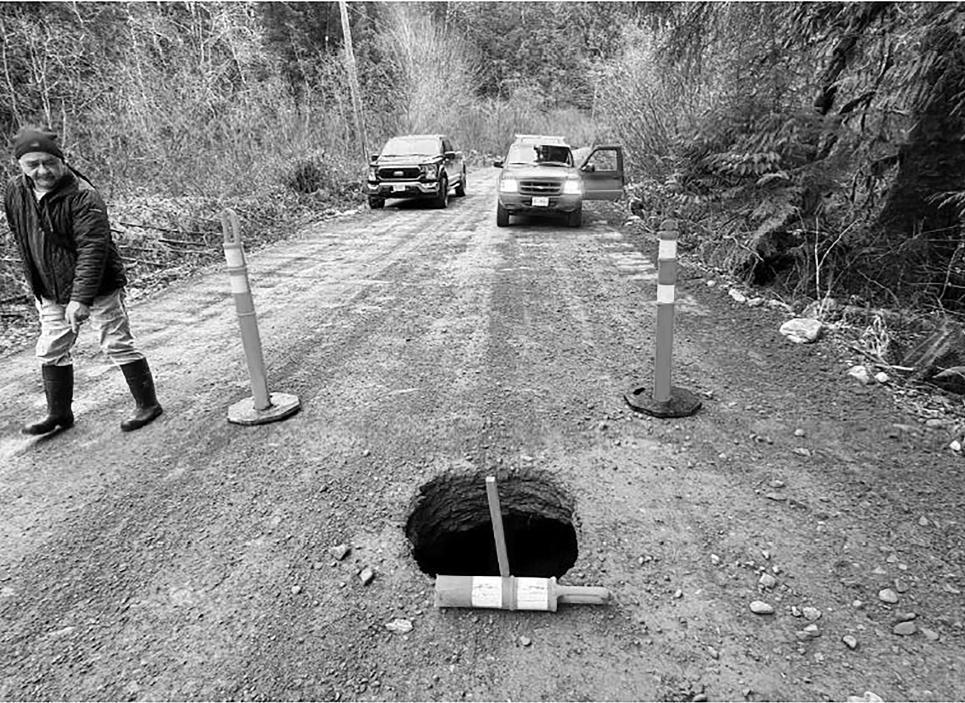
ers remained notifying motorists of the hazardous part of the road.
“It’s stable on the single-lane traffic side,” said Thomas. “Steps are being taken this morning for a permanent fix.”
But this raises the likelihood that other sections of the road to Nitinaht could collapse in the future, which is something that the First Nation intends to investigate. The road that collapsed is under the management of a forestry company.
“They usually maintain the road when they’re actively logging,” said Thomas. “However, when they’re not actively log-
On the morning of Feb. 10 a sinkhole large enough for a person to fall into was found on the road to Nitinaht. Within four hours a crew from the Ditidaht First Nation has stabilized the road enough for a single-lane passage. upgrade in recent years. Last October marked the completion of the chip sealing, an alternative to paving which uses an asphalt emulsion. Initially budgeted for $30.7 million, the province pledged $25.7 million for the project, with the remainder covered by the Huu-ay-aht First Nations. Costs escalated over the three years of road work, tasking the Huu-ayaht to find more funds last year to finish the safety upgrade. The provincial government put in another $10 million, and with an undisclosed amount of additional investment the Huu-ay-aht celebrated the upgraded road last fall.

ging, the road does not get maintained.”
“Access to Nitinaht Lake and Nitinaht village is predominantly via permit roads that are held by timber forest licensees, who are responsible for maintaining the access route,” wrote the ministry of Forests in an email to Ha-Shilth-Sa, adding that to ensure safety it followed up with the licence holder. “We understand that they are currently working with the community, and the community has patched the road to allow access in and out of the village. Further assessment will be done by the licensee to determine next steps.”
For years the First Nation has been lobbying for improvements to the road. Aportion of the passage is susceptible to flooding from Nitinaht River, and during the migration of chum salmon in November fish have been seen swimming across the road during past years. In early 2023 a 2.8-kilometre bypass was completed, with a $1.7 million investment from the Ditidaht First Nation, plus assistance from the San Group. This bypass is north of the section where the sinkhole was recently discovered.
If travelling from PortAlberni, half of the route to Nitinaht is over Bamfield Main, which has undergone a major
Now it’s time to complete the job, bringing a safer route to Nitinaht, said Thomas. The need to bring it up to provincial standards became apparent last summer during the sudden reliance on the logging road during the Cameron Bluffs wildfire.
“I am going to be sitting with the minister of transport soon and advocating, of course, for paved roads. It needs to happen, long overdue,” said Thomas.
“Now we just need to finish that route from Franklin River out to Nitinaht and then back around to Lake Cowichan. I think with a team effort we can make this happen.”

Vancouver Island, BC -An updated snow survey from the River Forecast Centre (RFC) for February shows Vancouver Island’s snowpack has decreased by nine per cent from the previous month.
Sitting at just 30 per cent of normal, Vancouver Island’s storage on snow in the mountains has seen a decrease since last month, similar to six other communities in the province.
Vancouver Island is 45 per cent lower than it was in February 2023, marking the second largest decrease in the province.
As of Feb. 1, the province-wide snowpack remains very low, averaging 61 per cent of normal across British Columbia.
Last year, the provincial average was 79 per cent for Feb 1.
According to experts at the RFC, low snowpack and seasonal runoff forecasts combined with warmer-than-average weather and the lingering impacts from previous dry seasons are creating significantly elevated drought hazards for this upcoming spring and summer in the province.
“There are still two to three months left in the snow season. While conditions may change slightly over this period, current trends in low snowpack are expected to persist,” states the snow survey. “Due to the extremely low snow conditions, below normal spring freshet flood hazard is expected this season, especially in the Interior.”
Vancouver Island’s Snow Basin indices decreased relative to normal due to very warm late-January temperatures and

heavy rain that caused significant snowmelt, according to the RFC.
Snow basin indices across the province are much lower this year compared to 2023 due to very dry and warm conditions through the snow accumulation season.
Matt MacDonald, lead weather forecaster with the BC Wildfire Service, said it’s a common misconception that the amount of overwinter snow has a direct impact to the following wildfire season.
“Several factors including sublimation, rate of melt and whether the underlying substrate is frozen, affect the effectiveness that snow melt has in recharging the underlying fuels and vegetation with
moisture,” MacDonald said. “Some of our most active wildfire seasons, namely 2003, 2017 and 2018 followed on the heels of deeper than normal snow packs.As always, the amount of rain we receive in June will determine the severity of the 2024 fire season.”
In 2023 there were 281 wildfires on Vancouver Island, 56 per cent of which were human-caused.
The low snowpack levels and unseasonably warm weather are creating a significant drought risk for this year, therefore the Province of BC is reaching out to farmers and other water users to help prepare for dry seasons and to understand their water management decisions.
The Ministry ofAgriculture and Food is working with the Ministry of Water, Land, and Resource Stewardship to improve communications with B.C. producers about how to prepare for drought and how water management decisions are made during drought conditions.
The province will be hosting upwards of 30 in-person and online information sessions throughout B.C. between March and May 2024.
An agriculture water management workshop was held in PortAlberni on Feb. 16, and there will be a decoding drought management engagement session in Courtenay on March 5 and one in Cowichan on March 6.

Nootka Sound, BC - If you want to save Pacific salmon from extinction, stop logging the forests they rely on for habitat.
This is the approach taken by the Mowachaht/Muchalaht’s Salmon Parks, an initiative that is quickly gaining steam in Nootka Sound, where the First Nation plans to have a significant portion of its territory protected from industrial logging in the coming years. Since getting word of over $15 million in federal funding at the end of October, the project has formed a society led by a seven-member board, including representation from the First Nation’s Council of Chiefs, the Mowachaht/ Muchalaht community, band administration as well as three directors from conservation and economic development sectors in the region. The initiative now has five permanent staff, two of whom are Mowachaht/ Muchalaht members. Other funding has been secured from a number of conservation groups.
The Salmon Parks project application says that if the status quo continued, all old growth in Mowachaht/Muchalaht territory would be logged in the next 15 years. Without serious intervention, this puts Nootka Sound’s salmon stocks at risk of facing extinction over the next two decades, after 90 per cent of the region’s salmon population has declined since industrial forestry took hold over the past century.
Hereditary Chief Jerry Jack has seen the rivers in his territory dry up over his lifetime, but the full extent of how much the area has been transformed became clear during a flight he took over the past year.
“I never realized how much devastation there was by logging. It’s really sad,” said Jack, noting that although he’s not against forestry harvesting altogether, sustainable practices are needed. “We’re slowly losing everything, and things have to change. The logging practices have to change, because they’re eating our rivers.”
Although he’s just in his 40s, Jamie James recalls a time from his youth when salmon filled a stream running throughAhaminaquus Creek, by a reserve on Muchalaht Inlet where the First Nation once had a village.
“That back river used to be just loaded with chum, all year round,” said James, who is now Mowachaht/Muchalaht’s field logistics coordinator. “Now you don’t see them at all anymore.”
Salmon Parks are now recognized under Mowachaht/Muchalaht law, but they have yet to receive any designation by the Province of British Columbia. Even so,
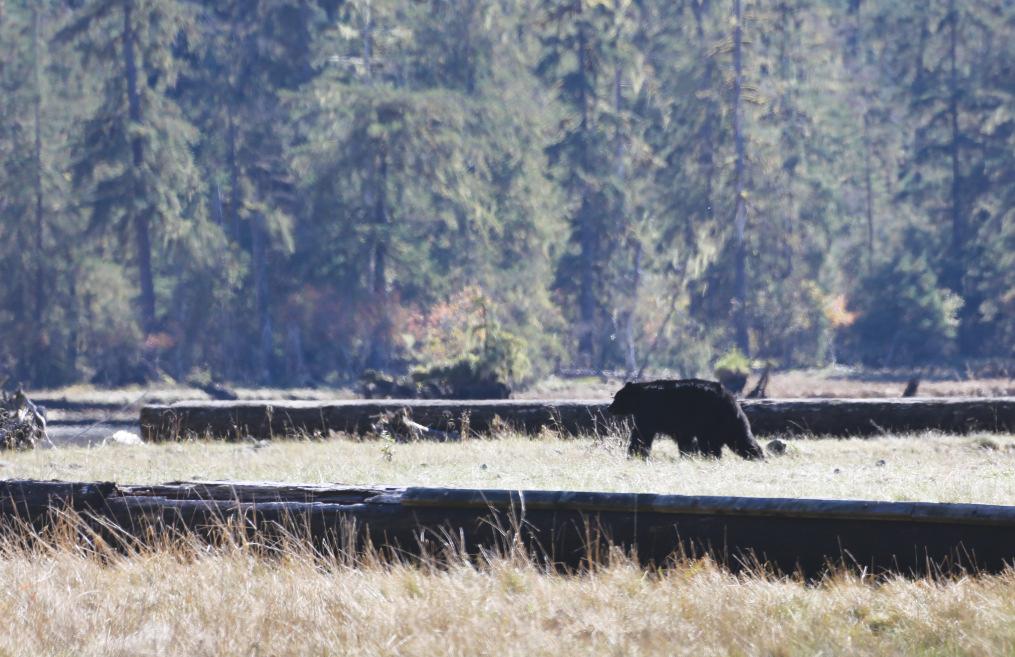
the recently awarded funding will protect almost 39,000 hectares of old growth in the First Nation’s territory, ancient forest that contains “critical salmon ecosystems”, according to the project description. This will halt industrial-scale logging in the Salmon Parks, but smaller operations can continue, such as hunting, fishing and the harvesting of trees for cultural purposes. The Salmon Parks are intended to eventually encompass 66,595 hectares by 2030 – the same year that the province has pledged to have 30 per cent of its land protected.
Logging tenures on Crown land in the region are currently held by Western Forest Products and BC Timber Sales. Of the over $15 million recently granted by Environment and Climate Change Canada, almost $12.5 million is allocated for land acquisition costs, notably buying out tenures that are currently held by forestry companies.
“It’s the single most important intervention we can take to help salmon,” said Eric Angel, general manager of the Salmon Parks Stewardship Society. “We can’t really do much about ocean warming, we can’t do much about the climate change impacts…in the big picture, climate change is just something we have to adapt to. But we can absolutely stop cutting down the old growth around those key habitats for

salmon spawn, and that will make a huge difference.”
In recent years concerns have intensified about the future of Pacific salmon. In February 2023 the First Nations Fisheries Council of B.C. raised the alarm by announcing a coalition formed to halt the path to extinction, citing that 90 per cent of Pacific salmon stocks have declined since the 1970s.
“I cannot imagine the cultures of the West Coast people without salmon, it would be difficult,” said Hugh Braker, president of the First Nations Fisheries Council, during the coalition announcement a year ago. “We believe that the choices made by British Columbians today will have an effect on the future for the returns of salmon.”
On the west coast of Vancouver Island, several stocks of chinook are listed as “under threat” by the Committee on the Status of Endangered Wildlife in Canada. Meanwhile the Tla-o-qui-aht have not allowed their members to harvest sockeye from the Kennedy Lake system since 1992, hoping
that the prolonged closure will one day allow salmon to return to a river that once supported commercial fishing.
In June 2021 Fisheries and Oceans Canada announced the Pacific Salmon Strategy Initiative, a $647 million plan to protect and rebuild stocks through improved scientific monitoring, habitat rehabilitation and boosting breeding from hatcheries. Aportion of the PSSI bank is going toward payments to retire commercial fishing licences, thereby thinning the fleet to lessen salmon population losses from harvesting. Licence buyouts are nothing new in B.C., and the commercial fleet has been reduced to roughly half of what it was in the 1970s.
But despite fewer commercial boats on the water and more fishery restrictions, salmon have continued to decline, leading some to wonder if more voluntary retirements will help with the continued decline of the species.
“I would have blamed it on overfishing earlier, absolutely, but because hatcheries have increased the fish in the system, you would think there would be more fish,” said James, noting that a major threat to
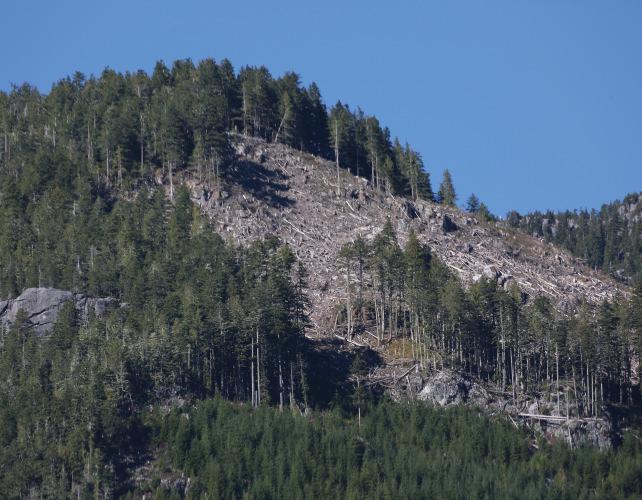
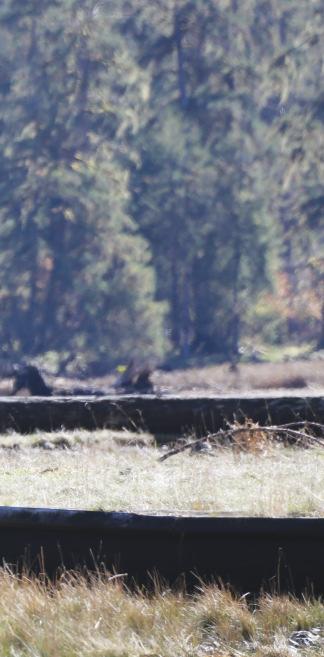
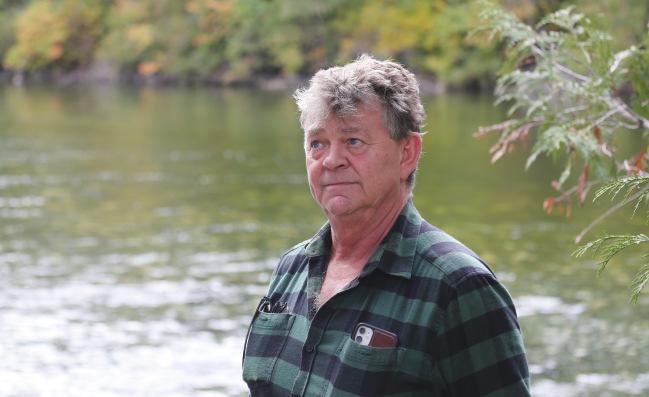
salmon eggs cool. The shade also reduces algae and other plants in the stream, which reduces the amount of oxygen for salmon,” she explained. “These riparian ecosystems, they provide so much for young salmon. The leaves, the needles of plants, they have insects, which fall into the water…the roots from the trees help to stabilize stream banks and slow erosion, which reduces the amount of sediment.”
“For quite some time now DFO has really neglected the importance of old growth forest habitat as essential to survival of salmon populations,” he said. “The reason it hasn’t been tackled until now is politically it’s challenging to make it happen, but that’s changing.”
B.C.’s great mistake
“There is literature to suggest that once a system has been clearcut or logged, replanted forests are not capable of providing the same sort of hydrologic function as these mature old growth forests for decades,” explained Connors. “Not having clearcutting - or thinning or selecting individual trees for harvest - this can help to minimize the impacts, as well as having a buffer around salmon streams. That’s not always something we see.”
“We’ve created these massive plantations across British Columbia of Douglas fir super trees that are designed to grow faster,” added Dunlop. “But nobody thought that was going to create a water demand and dry up the coho creeks across British Columbia.”
Forestry is often considered the industry that for generations powered development in B.C., sometimes establishing towns overnight around mills located by the deep waters of an inlet - as was the case with Gold River’s establishment in the 1960s.
Eric Plummer photos Mowachaht/Muchalaht’swill
salmon would become more evident if hatcheries ceased to breed fish. “You’d see the fish stocks decline really fast because of logging. There’s no spawning habitat.
People think that it’s because of overfishing - it’s the habitat that’s the issue.”
According to the Pacific Salmon Foundation, approximately half of B.C.’s 9,000 wild populations of the species are in some sort of decline. Salmon that spend more time in rivers and lakes appear to be particularly threatened.
“Pretty key parts of the salmon lifecycle are tied to these terrene aquatic landscapes, everything from spawning to the initiation of juveniles really depends on the state of trees surrounding salmon streams,” said Katrina Connors, program director for the PSA’s Salmon Watersheds Program. “Generally, the bigger and older the forest, the better salmon will fare.”
Connors noted that old growth trees are “critical” for healthy salmon ecosystems, including the shade they provide for spawning habitat.
“This is really important for keeping

The State of Canadian Pacific Salmon, which was published by DFO in 2019, details the complex factors that have contributed to the species’decline, including the effects from a warming climate, ocean heat waves that alter food sources when the salmon migrate out to sea, and rising air temperatures. The department also acknowledges that historic logging has damaged riparian zines next to streams, warming water in the summer, while contemporary forestry can also “contribute to landslides if significant portions of watersheds are cleared or roads are built with poor drainage.”
“Wood and debris from old growth trees plays an important role in shaping the character of smaller coastal stream systems and provides places for fish to live and hide from predators,” wrote the DFO in an email to Ha-Shilth-Sa. “Shade from trees regulates stream temperature during hot weather, providing cooler water that salmon need to reproduce and grow.And mature forests act as sponges that soak up rainwater and feed it back into streams during drier seasons and drought.”
The federal department is involved in a number of projects to help salmon in Nootka Sound, such as exploring restoration strategies like artificial beaver dams that “help moderate water flows in droughtprone systems, promote water storage, and increase water availability through periods of water scarcity.”
But an obvious factor has yet to be attacked, saidAngel.
In early October 2023 Vancouver Island was still parched from a particularly long, dry summer. Roger Dunlop walked through a park in Gold River, pointing to a mosscovered old growth tree towering over the path.
“When you look at these hemlock trees, like that one, it’s pretty much water. It’s a column of water stretching up into the sky,” said Dunlop, who is the Lands and Natural Resource manager for the Mowachaht/ Muchalaht First Nation. “Every piece of wood that you see laying on the ground here is storing water.”
But this natural system has been disturbed by what the province’s Vancouver Island Land Use Plan calls ‘tree farm licences’, resulting in a patchwork of forest that fails to provide the cohesive ecosystem that salmon need. The Mowachaht/Muchalaht have decided that the wide-ranging protection of Salmon Parks is the necessary solution to British Columbia’s great mistake, said Dunlop.
“We have come to the conclusion that those little band aids on the landscape don’t conserve ecological function,” he said, stressing that what’s needed is “whole watershed preservation to allow those functions to heal. These rivers are like Humpty Dumpty; all the king’s horses and all the king’s men are never going to put these rivers back together again. The only thing that will heal it is the forest.”
Crown land that gets logged is required to be reforested, but the demands of these young trees can create issues by absorbing an unbalanced volume of water.
“In the 50, 60 years since this timber farm licence came into existence in the 1950s there’s been upwards of $6 billion value of trees that have been harvested here.Atiny fraction of that has stayed in the community,” saidAngel, adding that most of the area’s forestry jobs go to people who commute into Gold River. “It’s a profoundly extractive economy. It’s an economy that comes in and takes and leaves very little behind.”
According to B.C.’s Ministry of Forests, old growth logging has slowed down in recent years.
“Between 2019 and 2021, an average of 2,707 hectares of old growth was harvested annually from publicly managed lands on Vancouver Island – that’s only 0.3 per cent of the total estimated amount of old growth on Vancouver Island,” stated the ministry in an email to Ha-Shilth-Sa. “By prioritizing sustainability, we will ensure that our oldest and rarest forests are protected, while supporting local, sustainable jobs.”
Furthermore, 2.42 hectares of B.C.’s old growth has been deferred from harvesting since November 2021. That’s in addition to the 3.8 million hectares that were already protected from being logged.
ButAngel believes that a more permanent solution is needed, one that Dunlop estimates could take hundreds of years.
“What we’re trying to do with Salmon Parks is lock in those protections so we’ve got that long-term assurance of protection for that habitat,” saidAngel. “Old growth ecosystems are salmon ecosystems. They evolved together.”
This story was made possible in part by an award from the Institute for Journalism and Natural Resources and the Gordon and Betty Moore Foundation.
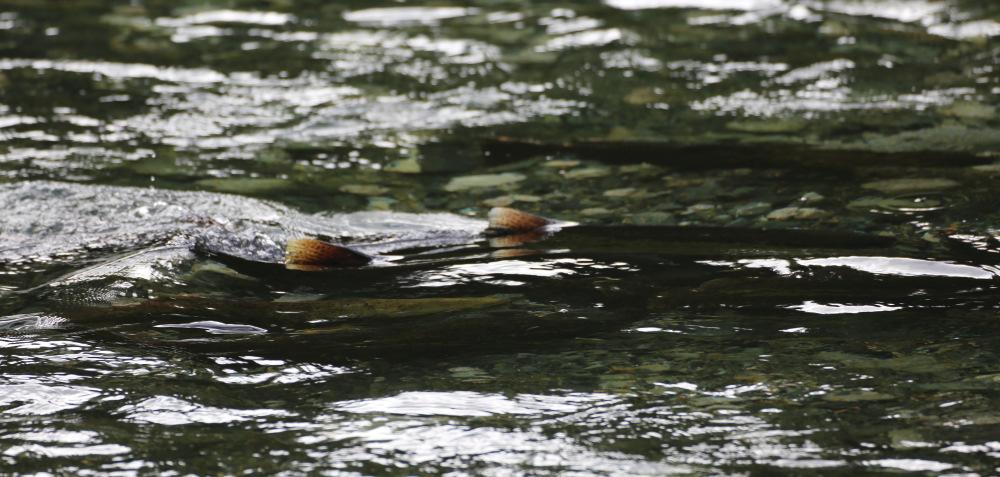
Ahousaht, BC - Since the start of the new year dozens of youngAhousaht members have been preparing to showcase their nation’s dances at an upcoming event in Vancouver.
At least 35 students will be making the trek fromAhousaht’s Flores Island village to the Hoobiyee event, which is scheduled for March 1-2 at the PNE grounds in Vancouver. For over a month the young dancers, who range in age from Grade 5 to 12, have been practicing two to three times a week inAhousaht’s T-Bird Hall and the school gymnasium.
“They’re always very eager,” said Ciiqaptuulthaqsa, Terry Robinson, a teacher in the community who is helping to prepare the dancers for the annual cultural event. “They connect with our culture really well.As we progress through the dance practice, their confidence builds in learning new dances.”
This will be the fifth year that Ciiqaptuulthaqsa has brought a group to Hoobiyee, and she said thatAhousaht tries to change the dances that are brought to Vancouver each time they attend the event. Cultural leaders in the community work with students to decide on what dances to perform, she said, and this year the group’s offerings incude a flag song from Kelsmaht, one of the tribes that amalgamated intoAhousaht during the 20th century.
The students also learn about the importance of asking the owners of the dances permission to perform them.
Ciiqaptuulthaqsa has seen some of her shy students “come alive” as they perform their nation’s dances.
“They’re more in tune with themselves in singing and dancing,” she said. “They’re connecting with their ancestral roots in that way. I’ve seen a really dramatic change with my really shy students.”
The group will be performing in regalia from the Maaqtusiis school’s culture room, including pieces made of woven cedar bark.
“We had as young as Grade 3s helping
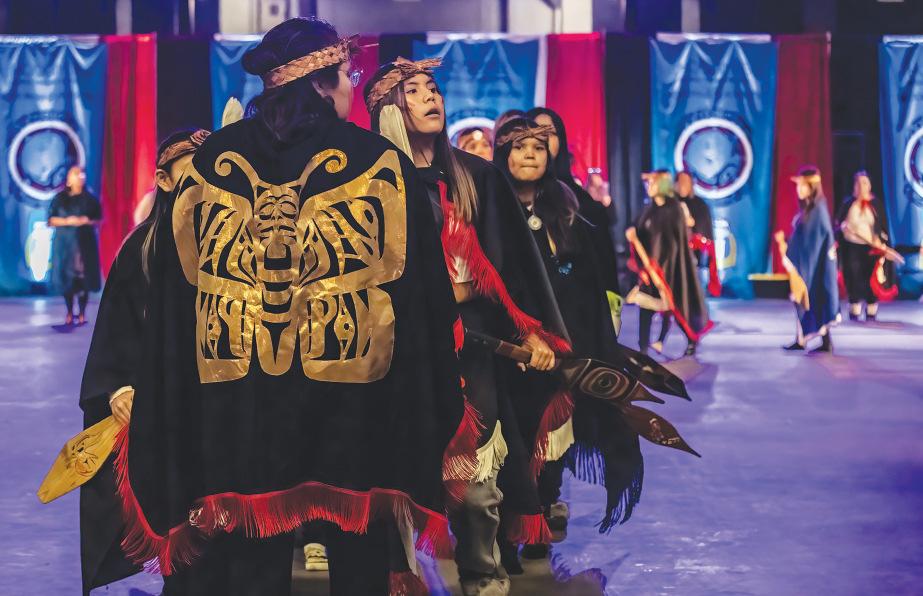
with the cedar regalia last year, learning how to thin it and strip it, weave it together at the top with the string,” said Ciiqaptuulthaqsa. “Yesterday we had our first regalia practice. For them to put the regalia on gives them the enthusiasm to try harder when they’re dancing.”
Hosted by the Nisga’a Ts’amiks Society on the traditional territory of the Musqueam, Squamish and Tsleil-Waututh First Nations, the annual event marks the start of the Nisga’a new year – beginning the nation’s harvest season when the small oolichan fish return to the Nass Valley. In this northwestern part of the province, the oolichan were traditionally the first food to arrive in the Nass River at a time when winter supplies were almost depleted.After about two months, the spring salmon would follow.
Certain members of Nisga’a society were experts in reading the moon and the stars, and the arrangement of these celes-
tial bodies could be used to predict the weather and the abundance of resources.
“Over time, they observed that whenever the first crescent moon (thin-shaped) is in the shape of the Hoobix – the bowl of the Nisga’a wooden spoon with ends pointing upward, this meant abundant resources in the harvesting seasons to follow in K’alii-Aksim Lisims (the Nass Valley),” reads a document from the Nisga’a Lisims Government. “The oolichans would be plentiful, the salmon… berries…and various other resources important to the Nisga’a; all in all, a bountiful year predicted.”
With so many members living away from their home territory, for several years the Nisga’a Ts’amiks Society has hosted the cultural event in Vancouver. The convergence of many cultures from across British Columbia provides an exciting experience for the many youth venturing fromAhousaht, who will be
accompanied by adult singers and other chaperones, making their contingent total about 50.
Last yearAhousaht member Greg Louie even managed to connect with one of the parents to get the youngsters into a Vancouver Canucks game, said Ciiqaptuulthaqsa.
“Some of our students don’t get to leave the reserve very often, so going to the big city like Vancouver is quite the experience for them,” she noted. “It’s an awesome experience for our kids. They get to connect with even urban family members.”
Other Nuu-chah-nulth groups are also scheduled to perform at Hoobiyee, including youth from the Huu-ay-aht and Tseshaht First Nations. The event begins with a welcome feast on Thursday, Feb. 29, followed by two days of performances on March 1 and 2 at the PNE Forum, 2901 East Hastings Street, in Vancouver.
Phrase†of†the†week:†Ma%ayi>†n’aas†wiiyaasum>†h=ayu%uh=%iš††cawaakum>† +u>ic^%aqniš††ma%ayi>†q’aanun%aqkin†niwa†yaa%akuks†siiwa†c^uu†
Pronounced ‘Naa ee yii alth nags eee yaa som alth clu ee gym ugh ee nas clue ee chilt haa my yii ilth ugk kin kaa num ugk kin yaa ugk kooks nee wa choo’, it means ‘A very special day to reflect on how we treasure our dear families. I love you all now and forever, Cuu’. Supplied by ciisma.

Play follows an Indigenous family whose father invites a priest from Montreal to live with them
By Karly Blats Ha-Shilth-Sa ContributorVancouver, BC -An Indigenous focused theatre production coming to Vancouver will feature Nuu-chah-nulth actor Danica Charlie.
Charlie, who lives in Vancouver, is from theAhoushat First Nation on her dad’s side, and of European descent on her mom’s side.
Charlie said she hasn’t been toAhousaht since she was a kid and grew up in Victoria.
She’s playing Maryanne in theArts Club Theatre Company’s production of Father Tartuffe:An Indigenous Misadventure.
The play is an adaptation of Molière’s play Tartuffe and follows the adventures of an Indigenous family whose father invites a priest from Montreal to live with them in their home.
Playwright Herbie Barnes, fromAundeck Omni Kaning First Nation on Manitoulin Island, said the story takes place in 1967 in a time when First Nations just recently got to vote and just seven years after they were considered citizens of Canada
“The father of the family has decided that he wants his family to learn the white man ways, as my grandfather did with my mother,” Barnes said. “He brings home this priest from Montreal who’s going to teach them religion. [The priest] is nefarious and he’s more interested in trying to seduce the wife of this man. It’s people being fooled by this priest and it’s a comedy, it’s fun, it’s a farce.”
Barnes said he was inspired to write an adaptation of Tartuffe after seeing the play. He wondered why anybody would be fooled by the priest, and reflects that his mother was persuaded to learn the white language instead of her own Indigenous language.
“I really wanted to adapt that piece because I saw our voice in there,” Barnes said.
All but one of the cast of Father Tartuffe is made up of Indigenous actors.
Barnes said he’s noticing more and

more Indigenous representation in theatre and writing.
Nuu-chah-nulth actor Danica Charlie will play Maryanne in the upcoming theatre production of Father Tartuffe:An Indigenous Misadventure. The play runs from Feb. 22–March 24 at the Granville Island Stage, 1585 Johnston Street, Vancouver. reputable theatre company in Vancouver so it’s definitely a big accomplishment for me. It’s been one of my career goals since getting out of school.”
“When I started out…35 years ago there were very few (Indigenous actors) and you could easily say, ‘Well, I’ll just use a guy that looks native,’and that’s not allowed anymore,” Barnes said. “There’s sort of this push for ‘nothing about us without us’.”
Although Barnes wrote the play, he is not directing it as he lives in Toronto. But he did suggest Musqueam artist Quelemia Sparrow to co-direct and be an Indigenous voice behind the scenes.
Danica Charlie is playing Maryanne, the daughter of the family.
“She is super in love with her boyfriend that she has been with basically since she was a kid,” Charlie said. “They are
supposed to be getting engaged soon but that kind of doesn’t work out because of Tartuffe.”
Charlie grew up as the shy kid in school and found that theatre was the perfect outlet to be more outgoing through the characters she played on stage.
“I found it a really great way to express myself and I just stuck with it,” she said. “I did it through elementary school, middle school and then high school I was in drama and musical theatre.”
After high school, Charlie attended the Canadian School of PerformingArts and graduated in 2021.
“Basically since I graduated I’ve been working professionally,” Charlie said. “This is my first time performing with [TheArts Club Theatre]. They are a very
Charlie said being an Indigenous actor can sometimes feel like you are a “token cast”, but she is seeing moreAboriginal representation in theatre lately.
“You’ll look around the room and you’re like, we’ve got one Indigenous person, oneAsian person, one black person,” said Charlie. “So sometimes you can kind of feel tokenized but I think things are changing and it’s becoming a bit less of that.”
Father Tartuffe runs from Feb. 22–March 24 at the Granville Island Stage, 1585 Johnston Street, Vancouver. More information can be found at artsclub.com.
PortAlberni, BC - The artwork of three Nuu-chah-nulth students now adorns
PortAlbreni’s Gyro Park after anAlberni District Secondary School art class was assigned to paint garbage bins throughout the community.
Maddexx George, Summer Little, and Maddison Lucas decided the theme of their project would be Indigenous art.
“I chose the cixʷatin, which is the eagle,” said George. “I chose it just [because] it’s my favorite animal.”
George explained that in Nuu-chahnulth culture, cixʷatin (eagles) are spiritual animals.
“It’s the closest one to the spirits,” explained the Grade 9 student.
At the top corner of George’s artwork, he painted the four nations color wheel which represents Black, European,Asian and Native people, each occupying a quarter of the circle, showing how everyone is connected.
It took George nearly four weeks to complete his artwork from a bare garbage bin through to his completed piece in the
park.
“People [in] PortAlberni can actually see native art and who made it,” said George pointing to his name at the corner of the piece. “It’s real awesome that other people can see my art.”
“I hope they see it and they know that young people still know their heritage,” said George.
Orange and red handprints embellish the front of the bin, where the students collaboratively created an “Every Child Matters” panel.
Though this is George’s first artwork displayed in public, he’s been drawing since he started his schooling.
“I always loved doodling and drawing,” said George, noting that he enjoys creating Indigenous art with sceneries of trees, mountains and animals.
Elders, aunts, and uncles have helped George learn to draw and paint along the way, he said.
For the cixʷatin (eagle), George meticulously dotted paint along the thin lines of his art.
“The best way is just to slowly paint or drawing every day,” said George.

Hello to everyone.As we move into longer, brighter days and the promise of spring, we look forward to another year of good fisheries, gathering and other cultural activities.
My hearts are with you for those losses suffered in our families and communities. It is never easy to lose a loved one. Every loss is tough and leaves a hole in our hearts, families and communities.
There are many issues our communities are dealing with on the local level and at the larger political level.
One of the initiatives I have been working on for many years now is heritage conservation to protect our sacred sites and objects and pursuing management. With the province committing to implement the United Nations Declaration on the Rights of Indigenous Peoples (UNDRIP) through the Declaration on the Rights of Indigenous People Act (DRIPA) I was working through a process called the Heritage Conservation Act Transformation Process. We were working towards bringing amendments to the Heritage ConservationAct to the B.C. legislature this spring, sitting to achieve the things we want and need.
Unfortunately, we did not have a meeting of minds on the drafting and we have put off bringing amendments until after the next election. It is really too bad as we worked really hard on this, but we would rather make positive and meaningful changes to the act than only minor ones.Aletter went out to all First Nations in the past little while explaining this. We had produced a What We Heard report of the proposed changes and it reflects First Nation dissatisfaction with what was proposed. That report will also be emailed to communities shortly.
I continue to work on justice issues and in particular policing issues. Had a meeting with the acting commissioner of the RCMP and head of Indigenous policing to pursue better relations and to work on several issues. There is a willingness on their part to work with First Nations. We had as Nuu-chah-nulth drafted a protocol on how we would work together with RCMP, but did not have First Nations signing on as of yet. I will continue to pursue this as we need to continue our work on policing. We have not forgotten Chantal Moore and Julian Jones and so many others.
We had a meeting as the executive and directors with the Representative for Children and Youth (RCY) where she shared that she will be doing a larger review to investigate racism within the system and she will look into the Dontay Lucas case during that review.
I continue working on the gaming issues in the province. Trying to make opportunities for First Nations to locate gaming facilities in their communities and many other issues.
There has been a lot of controversy in the media lately about some changes B.C. wants to make around the LandAct. They are planning to amend the LandAct to allow for shared/joint decision over things within the act, like mining.
B.C.’s Declaration on the Rights of Indigenous peoplesAct (DRIPA) has two sections that provide for B.C. and First Nations to enter into shared/joint decision making. You would think that would be enough for shared decision making over all things. But their laws says every law must have a specific provision that applies to shared decision making. So the B.C. government it trying to do that with the LandAct. We also were doing it with the HeritageAct as well.
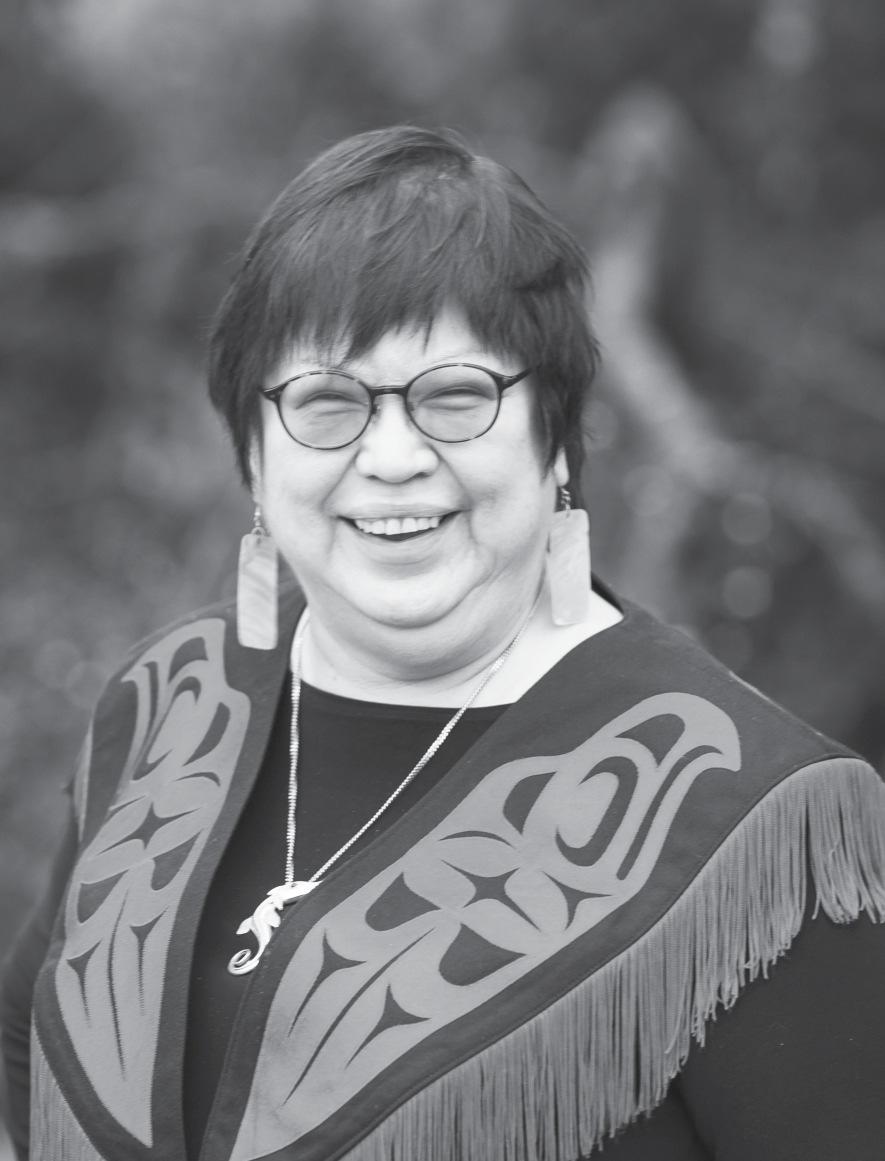
Many in the public are overly concerned about this. How can we have First Nations making decisions about our land, was a question frequently asked. Many worried we would make wrong decisions or take something away from them.
The reality is in five years only two shared decision making agreements have been reached and about two specific run of the river projects in Tahltan territory. The existing agreements were not related to large-scale decisions about land. It is a long, involved process to get the mandate from cabinet to negotiate an agreement, the actual negotiations and then back through bureaucratic processes to get back to cabinet approval.
This is a big problem with the existing system as DRIPAwas intended to make changes, but B.C.’s legislative processes are long and involved. They are also outside our consent and final decisions are always with the cabinet and legislature.
Avery important case came down from the Supreme Court of Canada. Quebec challenged the federal law over children and families. This law provides for First Nations to exercise their jurisdiction to pass laws over children and families.
Quebec said it was their law-making power and not the federal government.
The court ruled that Canada could pass this jurisdiction to First Nations. The court did not talk about the inherent right to jurisdiction for First Nations to pass their own laws in their own right. This is looked upon as a good decision and quite a few First Nations have passed their own laws under the Federal Children and FamiliesAct.
I attended the first day of the Council of Ha’wiih Forum on Fisheries. The meeting had to do with the Department of Fisheries and Oceans in relation to a paper they are putting together, a Habitat Restoration Priorities Plan for Pacific Region. They have been engaged in the process for some time now and are continuing to ask Nuu-chah-nulth for their input. Wanting to know specifics are important to us – Ha’wiih were very clear that all species are important to us. Also, what are our restoration goals, including ecosystem functions? It’s important to know what we think would make successful restoration programs. There was fulsome discussions and more discussions and work needed. Climate change, low ice packs, warming ocean temperatures, flooding and forest fires are part of the consideration. Restoring territories is a big job with many areas of habitat that need to be addressed and looked after. Restoration should have been done a long time ago and action is needed now.
Respectfully,
Cloy-e-iis

Connect Your Mind Body Spirit
February 26-29
Coast Bastion, Nanaimo
Wellness and self care. Hair cuts, massage, nails, key note speaker and much more. Open to all PES and IAFNYS clients.Accomidation provided, onsite child care, meals provided each day. Connect with your case manager to sign up. Northern region 250-720-1362. Central region 250-266-0275. Southern region 250-720-1132. IAFNYES 250735-1633
Chims Motel Grand Opening and Tour
March 1
Chims Guest House, PortAlberni
Join us on Friday, from 11:30am to 5:30pm for an exclusive tour. The official opening remarks will commence at 12:15pm.
Nuu-chah-nulth Baby Group
Every Monday
CYS - 4841 Redford Street, Port Alberni
10am-12pm. We offer Prenatal and infant development information, special guests, snacks provide and $20.00 food voucher per family. Referrals when needed. NTC Nursing and Doula’s 250-724-3939. Enter from 4th avenue side, building with orange stripe.


Girls Group
Every Tuesday
PortAlberni – Usma culture space
5:00pm-7:00pm Girls ages 13-18. Need a safe space? Want to express yourself? Looking to learn to bake and cook? Do you enjoy doing crafts? Come join us for fun activities with food and refreshments every Tuesday!
Eating in Balance
Every Wednesday
PortAlberni Friendship Center
1:00pm – 3:00pm. Participants work together to make a meal, discuss health and food related topics. Participants who work (cook and clean) with the group will receive a $10.00 grocery coupon that can be used at either Quality Foods or Buy-Low Foods. Childminder on premises.Adrop-in group, no registration required. For more information about our program, please call and ask forAmber –250-735-6276 ext. 233.Apart of theASI Early Years program.
Cultural Brushings with Quu asa
Every Friday
RedfordAdministration Building, Port Alberni
9:00am-12:00pm Cultural Brushings in support of the Tseshaht Community. If you have any questions, please call Leanne Harding,AdministrativeAssistant 250-724-1225

Correction:
In the Feb.8, 2024 issue Tianna Michael was the artist of the “we miss the sunshine” drawing. Previously shown as Tianna Morgan.

Port Alberni Friendship Centre Volunteers Needed
Need work experience? The Port Alberni Friendship Centre is looking for interested applicants for various positions. Call 250-723-8281


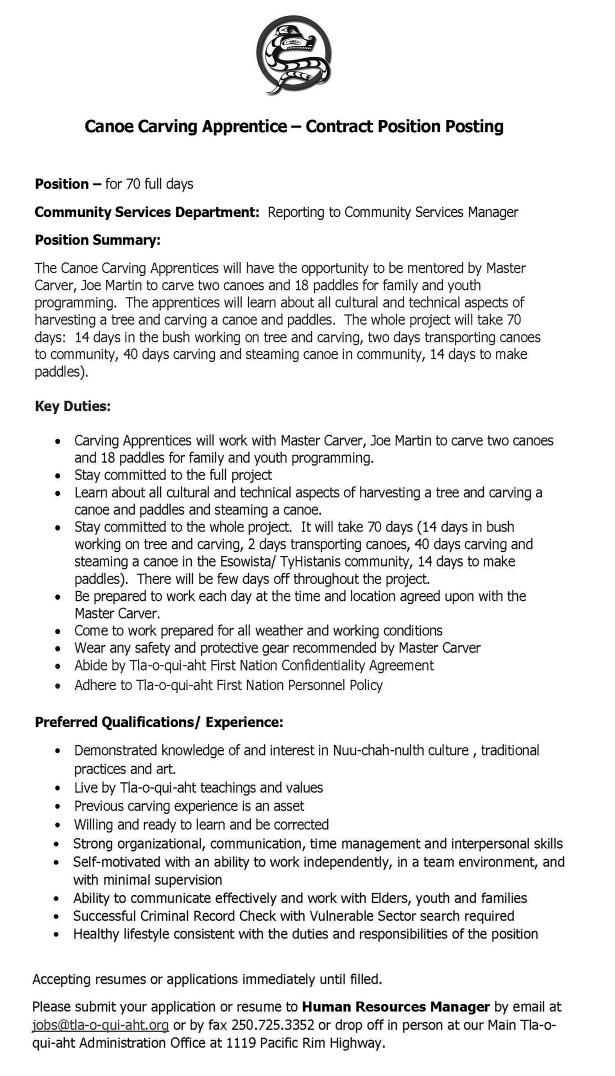
A restored E & N line would provide a needed alternate route to Highway 4 that was highlighted last summer
By Eric Plummer Ha-Shilth-Sa ReporterVancouver Island, BC -Apush is underway to restore Vancouver Island’s railway, with a call for the federal government to provide funding to a partnership that includes two Nuu-chah-nulth nations.
On Feb. 7 Cowichan-Malahat-Langford MPAlistair MacGregor presented a petition to the House of Commons with 7,610 signatures in support of bringing back passenger and freight railway service to Vancouver Island. The petition asks the feds to create a $1 billion fund to guarantee financing for the Island Corridor Foundation, a collective of several regional districts and First Nations along the route that owns the railway. Formed in 2003 to preserve what remained of the Equimalt & Nanaimo Railway, the ICF incudes theAlberni-Clayoquot Regional District and the Hupacasaht and Tseshaht First Nations.
Started by Victoria resident Warren Skaalrud, the petition notes that a railway will be needed when Vancouver Island is estimated to reach 1 million residents in 2030.
“Expanding the congested highway arteries on Vancouver Island would cost well in excess of $1 billion and would have high opposition risks from First Nations and citizens of Vancouver Island as such proposals have in the past,” stated the petition.
The document also notes the need for an alternate land passage to PortAlberni and the Island’s west coast communities. This became painfully apparent last summer, when a forest fire shut down Highway 4 at Cameron Lake for much of the season. Tourism-reliant operations in Tofino lost as much as 80 per cent of business, suffering an estimated $50 million in lost

Island Rail Corridor Condition Assessment, BC Ministry of Transportation and Infrastructure photo Numerous bridges supporting the railway need upgrades for the line to function again. Pictured is a bridge over Niagara Canyon near Victoria.
revenue.
The shutdown prompted several Nuuchah-nulth First Nations as well as the ACRD, District of Ucluelet and Nuuchah-nulth Tribal Council to send a letter to Premier David Eby, calling for the government to “create an official alternate access road to the west coast.”
“First Nations and theACRD in PortAlberni are both demanding a second route to ensure supplies, products, and people can move when Highway 4 is blocked,” noted the recent petition to restore railway service.
Originally built in 1886, the Esquimalt & Nanaimo Railway eventually stretched from Victoria to Courtney, with a line connecting Parksville to PortAlberni. This enabled European settlement across Vancouver Island, but after a century of operations, freight was in decline, while the automobile had established its role as the main source of transportation for Van-
couver Island residents. Passenger service to PortAlberni ceased in 1953, followed by the end of freight shipments to the valley a half century later. In 1979 Via Rail took over passenger service between Courtenay and Victoria, which ended in 2011 due to declining track safety. Now only the railway within a 16-kilometre radius of the Nanaimo harbour is being used to move freight, operated by the Southern Rainway of Vancouver Island.
According to a feasibility study commissioned by the province in 2020, 45 per cent – or an estimated 180,000 of the line’s railway ties - are “considered defective”. Parts of the railway, particularly the section that extends to PortAlberni, are overgrown with vegetation that would need clearing for service to be restored. On the PortAlberni extension alone bridge repairs were estimated to cost $34.7 million, with work needed on the
13 timber structures currently in place.
The 2020 study estimated a full restoration of reliable freight and passenger service to cost over $700 million.
Despite this daunting cost, last year the B.C. Ministry of Transportation and Infrastructure gave a sign of serious consideration towards railway restoration. In March the ministry granted $18 million to the five regional districts and 14 First Nations along the route to develop plans for the line.
During a past meeting of theAlberniClayoquot Regional District,ACRD Chair John Jack noted that the railway would bring socio-economic benefits for people throughout the region.
“From an economic standpoint, access to reliable transportation is the most important factor in people escaping poverty,” said Jack during the meeting, which was held July 27, 2022. “Child benefits, child tax benefits, these things all matter - but if you can’t get to work, if you can’t get to your appointments, if you can’t get to your appointments to heal your mind or your soul, you can’t escape the poverty track. This is going to free up space for people to be able to do that.”
Besides the cost of repairing and clearing the railway route, additional resources are needed to “reconcile and resolve long-standing First Nations’concerns with certain sections of the Island corridor,” stated the petition.
An example of what could lie ahead can be found in the case of the Nanoose First Nation, which fought in court to get its land north of Nanaimo returned from the railway last year.
According to the House of Commons’ petition procedure, a formal response from the government is due 45 days after the document was presented in Parliament.
PortAlberni, BC -Alberni District
Secondary School’s (ADSS) athletic department is formally renaming its sports teams, taking “Armada” off the court.
After four decades students, staff and coaches say the name “no longer has a connection” to the school community.
“We just felt thatArmada does not represent us a whole lot,” said Dennis Bill, a teacher and coach atADSS. “The students don’t connect with it; a lot of students don’t understand what an armada is [and]… it doesn’t match up with what we value.”
After conversations with coaches and students, they decided that “it was time to change the name,” said Bill.
But in 2012 whenADSS moved from its former location on Burde Street to its new building along Roger Street, their athletics department began working to simplify and reinvent theAlberniAthletics logo, sharedADSSAthletic Director Mike Roberts. Their first step was transitioning from the image of a schooner, a sailing vessel representing a Spanish fleet of ships, to the letterA, which appears in their school color, red.
“We kind of just went with what we thought was good,” said Roberts. “It stuck; everyone liked it.”
With First Nations culture, art, and truth and reconciliation in mind, their

next steps were to Indigenize their logo, shared Roberts, but it didn’t happen as soon as they hoped.
At their annual Totem tournament, Roberts recalled noticing several participating schools wearing their athletics logos with First Nations-themed designs.
“They beat us to the punch in our own house,” said Roberts. “This is great for those schools, it looked fantastic, but we need to do that as well.”
In collaboration with the athletics department, Geena Haiyupus then produced what is presently and widely known
acrossADSS as their logo.
“It was even more mainstream now than the firstA,” recalled Roberts.
“As an ex-student I have [an] attachment to the nameArmada, but at the same time, I see it as a great opportunity for us to grow and change and maybe adopt something that’s a little more suited to our values and our culture here at the school,” said Bill.
In the renaming process, they have established a committee responsible for deciding on the new nickname for teams. The committee will be gathering ideas
from the school and wider PortAlberni community, while meeting with Tseshaht and Hupacasath, shared Roberts.
In the renaming process, “Indigenous history and culture, athletics and school history, geographical location, as well as iconic events,” will be considered, reads anADSS athletic department press release.
“We are seeking a name that is bold, represents strength and power, and is a name that everyone can be proud of.”
“It would be great if we could connect it to our local Indigenous culture,” added Bill. “Being a member of the Tseshaht First Nation, I think it would be great if there was a way we could tie in either our language or culture into the school nickname.”
Bill hopes that the new name can be simply identified, includes community representation, and unifies the school.
“Just now… finally everything’s lining up and we’re able to move forward with looking for a new name that would, I think, identify us better, who we are, where we’re situated in PortAlberni, and that both coaches, teachers, students can relate to more,” said Roberts.
“It could be a place or something that people identify with,” said Bill. “But just something that really resonates with our students and our community.”
Team name ideas for the school’s athletics department can be submitted by scanning the QR code listed onADSS Athletic Department Facebook page.
Ehthlateese, BC – Uchucklesaht’s main reserve at Ehthlateese, a village of about 14 family homes, is getting clean, reliable energy in its growing community through funding from the First Nations Clean Energy Business Fund.
According to Nigel Moore, Uchucklesaht’s special projects manager, Ehthlateese has been growing rapidly over the past five years and is expected to grow further as more citizens make the move home to the pristine, waterfront village south of Henderson Lake.
But Ehthlateese is off grid and Moore says there is no chance that the remote community will ever be in the main BC Hydro system. The tiny village powers its homes and wellness centre on dieselfueled generators, operated by BC Hydro.
The generators are loud in an otherwise peaceful location and they require delivery and storage of diesel fuel to operate, running the risk of oil spills that would be disastrous for the environment. The community needs a clean, reliable source of energy for its growing population.
On Feb. 13 the B.C. Ministry of Indigenous Relations and Reconciliation announced that both the Uchucklesaht Tribe andAhousaht First Nation would receive funding to develop clean-energy projects.
The funding will allow the nations access to more efficient and sustainable sources of energy. Uchucklesaht Tribe will receive $499,140 to develop run of the river hydroelectric and solar-power initiatives.
“The nation will develop two clean energy projects over time to eliminate the need for diesel energy,” said Moore.
They have identified a creek that could support a run of river hydro electric system.According to Clean Energy BC, run-of-river hydroelectric (ROR hydro) projects generate electricity by channel-
replace diesel fuel

ing natural stream flows and utilizing elevation differences in mountainous regions.
According to Moore, the ROR hydro project would be ideal for Ehthlateese in the wet season near a place like Henderson Lake, known for its abundance of rainfall and clean water.
But with climate change and summer droughts, Uchucklesaht have plans for a back-up, complimentary clean energy system where they will harness solar power with the installation of solar panels on a local mountainside.
“We will use the resources available in our area and use them when they are in
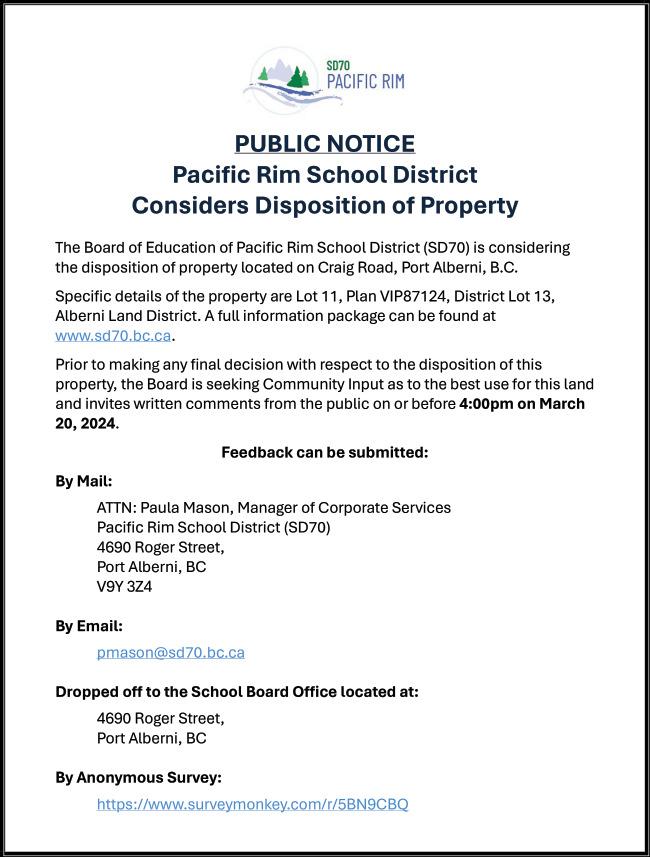
season,” said Moore.
“The B.C. government is working in partnership with First Nations to support resilient communities on Vancouver Island and the coast,” stated Murray Rankin, Minster of Indigenous Relations and Reconciliation, in a press release.
“Supported by the First Nations Clean Energy Business Fund, projects like the Uchucklesaht hydroelectric development will power remote communities and create economic opportunities,”
“Funding from FNCEBF makes an important contribution towards Uchucklesaht’s development of community-owned clean-energy systems in the village of Ehthlateese,” said Uchucklesaht Chief Councillor Wilfred Cootes Jr. “Developing new sources of clean energy is fundamental to the revitalization of the village and requires consistent efforts to invest in the design and development of new infrastructure over time.”
Moore stated that in addition to developing clean energy projects in the village, Ehthlateese residents now have a new water treatment plant and septic field.
“These partnerships with theAhousaht First Nation and Uchucklesaht Tribe will
support our CleanBC goals - empowering local economic development while mitigating the effects of climate change,” said Josie Osborne, Minister of Energy, Mines and Low Carbon Innovation.
Ahousaht First Nation will receive $50,000 from FNCEBF to develop a comprehensive community plan to identify energy-efficiency measures and explore potential clean-energy initiatives.
“Ahousaht is excited to move forward with clean-energy initiatives in our Nation and is grateful for the support from FNCEBF,” saidAhousaht Chief Councillor naasʔałuk (John Rampanen). “As a remote, coastal Nation we believe that the future of clean and sustainable energy is a vital part of our ongoing development and responsible stewardship over our lands and waters.”
The FNCEBF supports clean-energy projects led by First Nations communities, such as installing heat pumps and solar roofs, as well as improving insulation in homes, energy-efficiency planning and educational events. Six First Nations partners provincewide received a total of more than $1.8 million through the fund in this round of grants.

